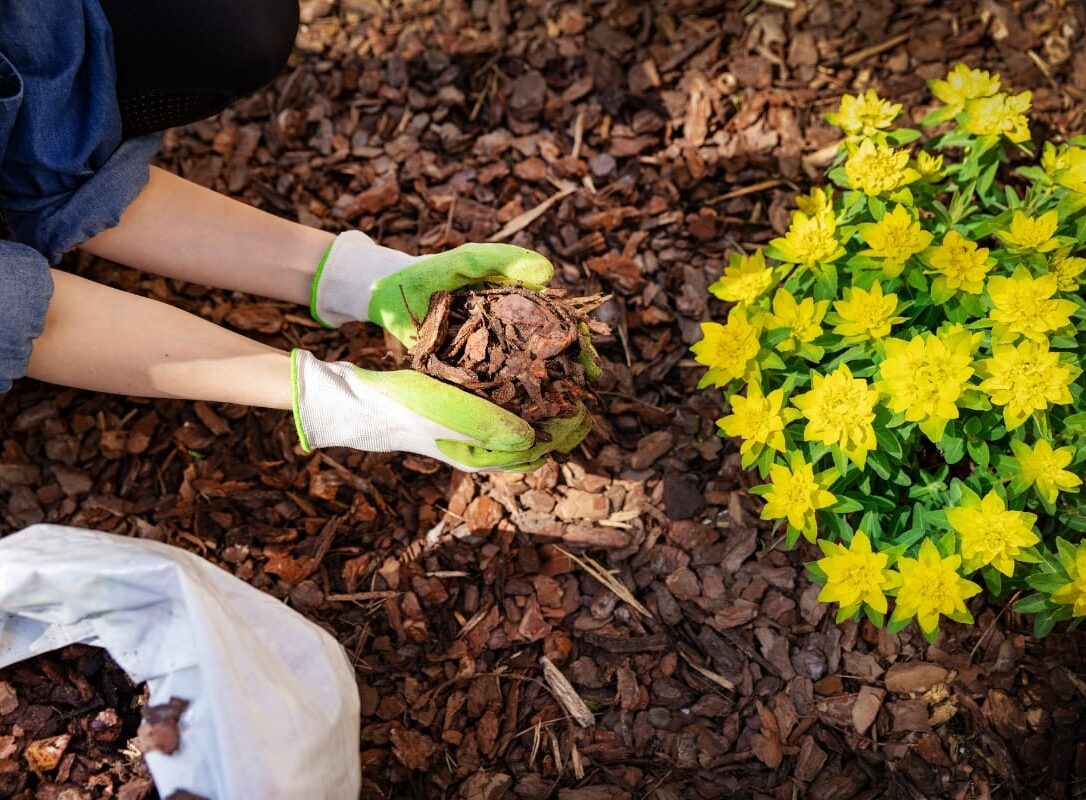Ever wondered how to make your garden healthier and more attractive? Mulching and edging are two simple techniques that can transform your outdoor space.
This article will explore the benefits of mulching for soil health and moisture retention, and how edging can create clean, defined borders in your garden.
You’ll learn practical tips for mulching around trees and edging flower beds, helping you maintain a beautiful, thriving lawn. By the end, you’ll have the knowledge to enhance your garden’s health and aesthetics with these essential landscaping practices.
How Mulching and Edging Can Boost Your Lawn’s Health
Understanding the Basics of Mulching and Edging
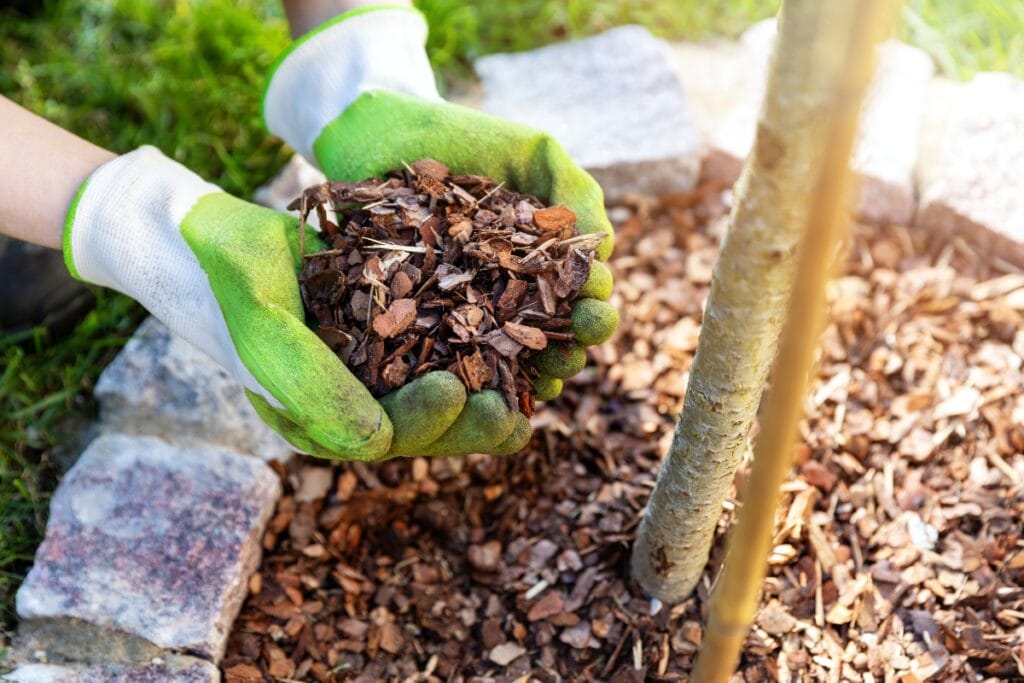
Mulching and edging are key practices in tree care and garden maintenance. They help prevent fungus, deter pests, and enhance your landscape‘s aesthetics. Understanding these basics will help you create healthier, more attractive outdoor spaces.
Let’s explore how mulching protects your plants, how edging defines your garden‘s structure, and how combining these techniques can yield optimal results for your trees and overall landscape design.
Defining Mulching and Its Purpose
Mulching is the practice of covering your garden bed with a protective layer of organic or inorganic material. You spread this layer around plants and over the soil to enhance the health and appearance of your landscape.
The purpose of mulching is to conserve moisture, suppress weed growth, and regulate soil temperature, creating an ideal environment for plant roots to thrive.
When you mulch, you’re not just improving the aesthetics of your garden; you’re also providing essential benefits to your plants.
By applying mulch around the base of trees and shrubs, keeping it away from the trunk, you create a barrier that helps prevent soil erosion and reduces water evaporation. Here’s a quick overview of mulching benefits:
Exploring the Role of Edging in Landscape Design
Edging plays a crucial role in landscape design by creating clean lines and distinct boundaries between different areas of your garden.
When you install edging, you establish a clear separation between your lawn and garden beds, preventing grass from encroaching on your mulched areas. This separation not only enhances the visual appeal of your landscape but also aids in weed control, reducing the need for herbicides.
You can choose from various edging materials, including wood, stone, or metal, to complement your garden‘s style. Wood edging, such as pressure-treated lumber or cedar, offers a natural look and can help retain heat in your garden beds.
When combined with woodchips as mulch, this creates an attractive and low-maintenance border that enhances your landscape‘s overall aesthetic while providing practical benefits for plant health.
Combining Mulching and Edging for Optimal Results
When you combine mulching and edging in your landscape, you create a powerful duo for garden health and aesthetics.
By installing edging around your mulched areas, you prevent your lawn mower from disturbing the mulch, keeping it in place and maintaining its benefits. This combination also helps retain nutrients in the soil, promoting plant health and reducing the need for frequent pruning.
Your landscape will benefit from the clean lines created by edging, while the mulch provides a uniform, attractive backdrop for your plants.
This pairing not only enhances the visual appeal of your garden but also simplifies maintenance. You’ll spend less time weeding and more time enjoying your outdoor space, as the edging keeps grass at bay and the mulch suppresses weed growth.
The basics of mulching and edging are clear. Now let’s dig deeper into how mulch can boost your garden‘s health.
Boosting Garden Health Through Mulching
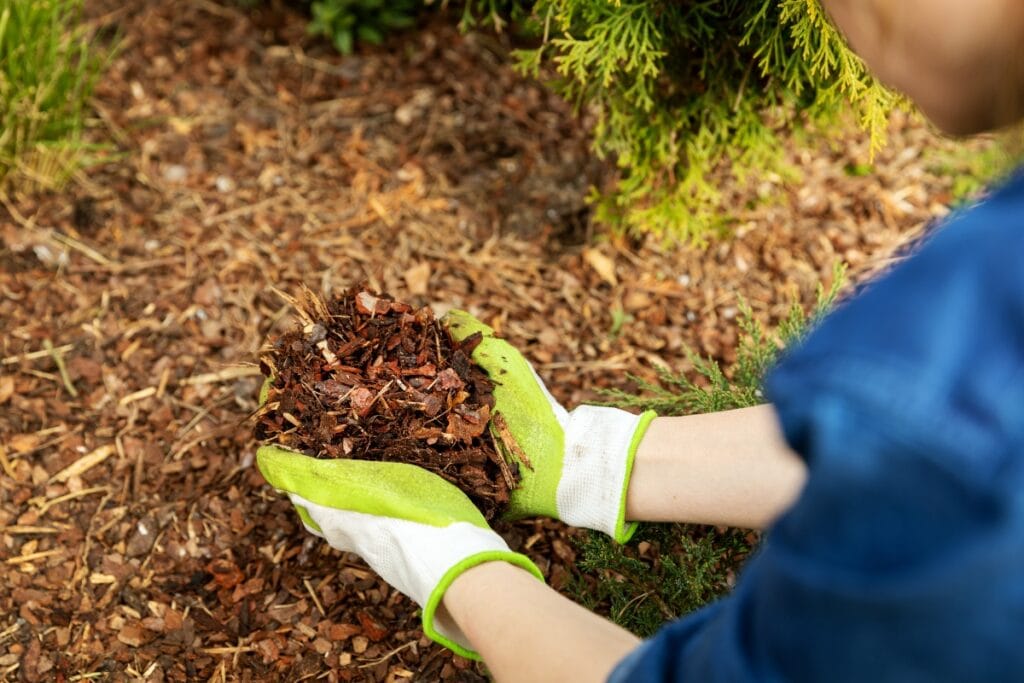
Mulching boosts your garden‘s health in multiple ways. You’ll learn how it preserves soil moisture, reduces weed growth naturally, enhances nutrients through decomposition, and protects soil from erosion and temperature changes.
These benefits improve plant growth, from shrubs to trees, making mulching a key practice in horticulture. Using an edger helps maintain clean borders, ensuring oxygen flow and soil health.
Preserving Soil Moisture for Plant Growth
When you apply mulch to your garden, you create a protective barrier that preserves soil moisture. This layer of organic material, such as pine needles or compost, acts like a sponge, absorbing water and slowly releasing it to the soil below. By reducing evaporation, mulch helps maintain consistent moisture levels, which is crucial for healthy plant growth.
You can maximize moisture retention by choosing the right type of mulch for your garden.
Organic mulches like wood chips or bark decompose over time, adding nutrients to the soil. However, avoid using plastic mulch, as it can lead to moisture buildup and potentially cause root girdling. Instead, opt for materials that allow water and air to penetrate while still providing excellent moisture retention:
Reducing Weed Growth Naturally
Mulching effectively reduces weed growth naturally by creating a barrier that blocks sunlight from reaching weed seeds. When you apply a thick layer of organic mulch, such as leaf litter or wood chips, you prevent weed seeds from germinating.
This method not only suppresses weeds but also adds organic matter to your soil as the mulch breaks down, improving overall soil health and reducing the risk of plant disease.
To maximize weed control, consider combining mulching with edging techniques. Create a shallow trench around your garden beds and fill it with brick or stone edging.
This creates a clear boundary that prevents weeds from creeping in from your lawn. Apply mulch up to the edge of this barrier for a clean, weed-free look. Here’s a comparison of different mulching materials for weed control:
Enhancing Soil Nutrients With Organic Mulch
As a homeowner, you can enhance your soil‘s nutrients by using organic mulch in your yard. When you spread organic materials like leaves, grass clippings, or compost, you’re feeding your soil naturally. These mulches break down over time, releasing essential nutrients that plants need to thrive in their natural environment.
To apply organic mulch effectively, use a shovel to spread a 2-3 inch layer around your plants, keeping it away from stems and trunks. This practice not only enriches your soil but also helps prevent erosion, especially on slopes or areas prone to heavy rainfall.
Your garden will benefit from this slow-release fertilizer method, creating a healthier ecosystem for your plants.
- Choose organic mulches like compost or leaf mold
- Apply a 2-3 inch layer using a shovel
- Keep mulch away from plant stems and tree trunks
- Replenish mulch annually to maintain nutrient levels
- Monitor soil pH and adjust mulch type if needed
Protecting Soil From Erosion and Temperature Changes
By applying mulch to your garden beds, you protect your soil from erosion and temperature fluctuations. A thick layer of straw or wood chips acts as a barrier, preventing soil compaction and improving drainage during heavy rains. This protection maintains your garden‘s aesthetics while ensuring your plants’ root systems remain stable and healthy.
You’ll also notice that mulch helps regulate soil temperature, keeping it cooler in summer and warmer in winter. This temperature stability is crucial for plant health and can be enhanced by using materials like pavers for edging.
The combination of mulch and proper edging not only improves your garden‘s look but also creates a more resilient growing environment for your plants.
Mulch nurtures your garden‘s roots. Now, let’s shape its edges for a crisp, clean look.
Enhancing Garden Appearance With Edging
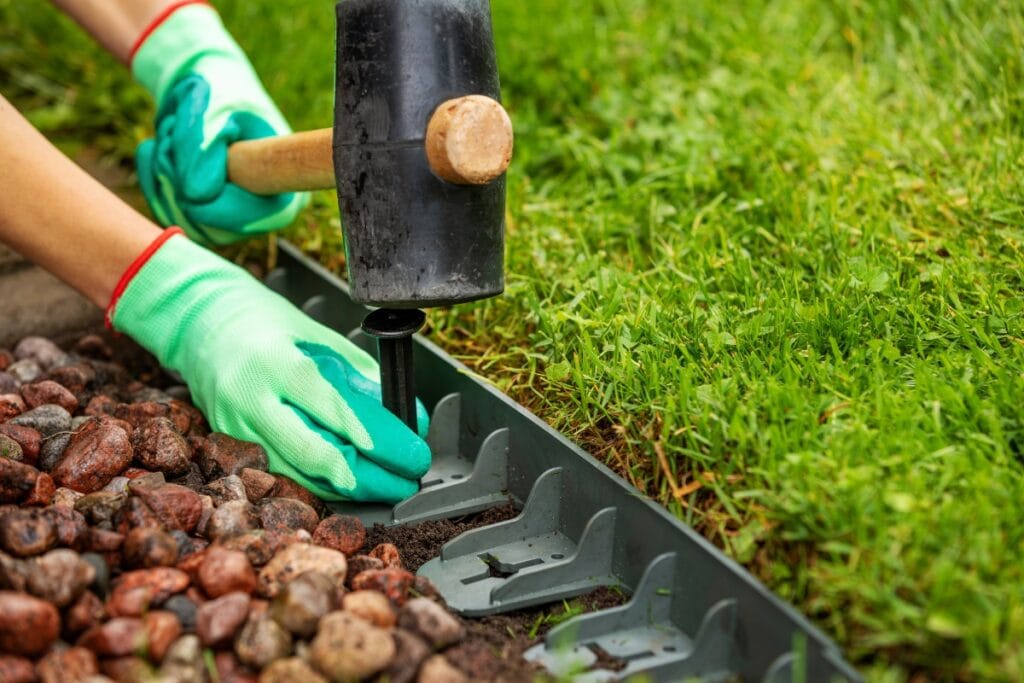
Edging enhances your garden‘s appearance and simplifies maintenance. You’ll learn to create clean boundaries, prevent grass invasion, and choose decorative materials.
Discover how effective edging techniques, using tools like a spade or string trimmer, can improve your landscape‘s look and make tree maintenance easier. These tips will help you achieve a polished garden that showcases your plants’ natural flare.
Creating Clean Boundaries in the Landscape
You can create clean boundaries in your landscape by using edging techniques that define spaces and enhance beauty. By installing metal edging or laying cardboard along your garden borders, you establish clear lines that separate different areas of your yard.
This not only improves the overall aesthetics but also helps maintain soil moisture by preventing grass from encroaching into your garden beds.
When you edge your garden, you’re not just creating visual appeal; you’re also making maintenance easier. A well-defined border allows you to mow and trim more efficiently, saving you time and effort.
Consider using materials that complement your garden‘s style, such as stone for a natural look or sleek metal for a modern touch. These clean boundaries will showcase your plants and create a polished, professional appearance in your outdoor space.
Preventing Grass From Invading Garden Beds
You can prevent grass from invading your garden beds by creating a barrier with effective edging. Use a sharp edging tool to cut a clean line between your lawn and garden, creating a small trench.
This trench acts as a natural barrier, making it harder for grass roots to spread into your beds. For added protection, install plastic or metal edging with a minimum diameter of 4 inches to block grass growth effectively.
To further deter grass invasion, consider laying a layer of cardboard or newspaper as a natural weed barrier before adding mulch. This method not only helps with pest control but also reduces evaporation, keeping your soil moist.
When removing existing grass, use a flat shovel to cut and lift sod chunks, ensuring you remove the entire root system. Here’s a comparison of different edging methods for preventing grass invasion:
Selecting Decorative Edging Materials
When selecting decorative edging materials for your garden, consider options that complement your landscape‘s style and provide functional benefits.
You can choose from a range of materials, including concrete pavers, natural stone, or even recycled materials, to create a unique border that enhances your garden‘s aesthetics. These materials not only define your garden beds but can also play a role in managing irrigation and rainwater runoff.
To maximize the impact of your edging, think about incorporating lighting elements into your design. Solar-powered lights integrated into your edging can illuminate pathways and highlight the beauty of your garden‘s canopy at night.
This approach not only adds visual interest but also improves safety and extends the usability of your outdoor space after dark.
Simplifying Maintenance With Effective Edging
Effective edging simplifies your garden maintenance by creating clear boundaries between your lawn and garden beds.
You’ll find it easier to mow and trim around your plants when you have a well-defined edge. This clean line also prevents grass from encroaching into your garden, reducing the need for constant weeding and reshaping.
When designing your garden‘s hardscape, consider using edging materials that complement your overall design. For example, you might use thyme as a living edge along pathways, adding both function and beauty to your space.
This approach not only enhances the garden‘s aesthetic but also helps suppress weeds and retain soil moisture, making your maintenance tasks more manageable:
- Choose durable edging materials that match your garden‘s style
- Install edging at the right depth to prevent grass from spreading
- Use edging to create distinct zones for different plant types
- Incorporate curved edges to soften the garden‘s shape and add visual interest
- Consider permeable edging to improve drainage and reduce runoff
Techniques for Edging and Mulching Around Trees
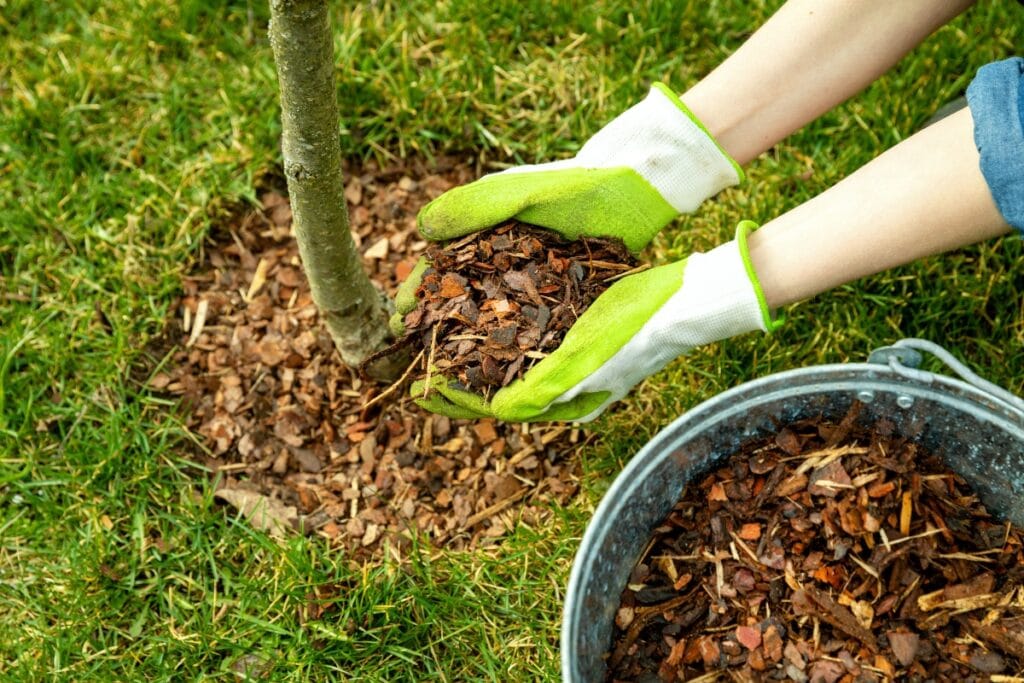
When mulching and edging around trees, you’ll learn how to protect roots, establish safe mulch rings, and choose suitable edging methods.
You’ll discover techniques to enhance infiltration and prevent rodent damage while avoiding common mistakes. These practices improve your landscape design, benefiting various tree species and adding a polished look with colored mulch dye.
Protecting Tree Roots With Proper Mulching
When protecting tree roots with proper mulching, you’ll want to create a wide, shallow layer of mulch around your trees. Start by removing any grass or weeds in a circular area extending from the trunk to the drip line.
Then, apply a 2-3 inch layer of organic mulch, such as wood chips or cocoa bean hulls, keeping it at least 6 inches away from the trunk to prevent moisture buildup and potential pest issues.
For effective landscape maintenance, consider using gravel as a base layer before adding organic mulch. This combination improves drainage and helps prevent soil compaction.
When applying mulch, maintain a slight angle sloping away from the tree trunk to direct water toward the roots. You can use a pallet as a guide to ensure an even distribution of mulch around the tree:
- Remove grass and weeds from the mulching area
- Apply a thin layer of gravel as a base (optional)
- Spread organic mulch 2-3 inches deep
- Keep mulch 6 inches away from the tree trunk
- Create a slight slope away from the trunk
- Use a pallet to ensure even distribution
Establishing a Safe Mulch Ring Around Trees
When establishing a safe mulch ring around your trees, start by creating a circle that extends at least 3 feet from the trunk.
Remove any grass or weeds within this area, and apply a 2-3 inch layer of organic mulch, such as wood chips or pine needles. Keep the mulch about 6 inches away from the tree trunk to prevent moisture buildup and potential pest issues.
For added interest, consider incorporating perennial plants or small rocks into your mulch ring. This not only enhances the aesthetic appeal but also mimics a forest floor environment.
Remember to maintain the mulch depth at about 2 inches, refreshing it annually to ensure your trees continue to benefit from this protective barrier.
Choosing Suitable Edging Methods for Trees
When choosing suitable edging methods for trees, consider options that protect the root system while enhancing your landscape‘s aesthetic.
You can use natural materials like river rocks or wood chips to create a soft border that allows for root growth and water penetration. These materials also blend well with the surrounding landscape, especially during the growing season when trees are in full bloom.
For a more defined look, you might opt for metal or plastic edging installed at least 2 feet away from the trunk. These materials can be painted to match your garden‘s color scheme, adding a pop of visual interest.
Remember to choose edging that allows for proper nitrogen cycling and doesn’t interfere with the tree‘s natural processes. Here’s a comparison of different edging methods for trees:
Avoiding Common Mistakes Near Trees
When mulching and edging around trees, avoid creating “mulch volcanoes” that pile mulch against the trunk. This common mistake can lead to root rot and pest issues.
Instead, create a border for your mulch bed using edging to keep mulch in place, ensuring it’s at least 6 inches away from the trunk. This practice promotes healthy root growth and prevents moisture-related problems.
Another mistake to avoid is using plastic or non-permeable materials as mulch bed edging. These can restrict water and nutrient flow to the tree‘s roots.
Opt for permeable materials like stone or metal edging that allow for proper drainage. When mulching and edging, remember to maintain a consistent depth of 2-3 inches across the entire bed, sloping gently away from the trunk:
- Create a mulch ring extending to the tree‘s drip line
- Use permeable edging materials to allow water flow
- Maintain a 2-3 inch mulch depth, sloping away from the trunk
- Refresh mulch annually to ensure continued benefits
- Monitor for signs of pest activity or root issues regularly
Trees need care, just like flowers. Now let’s turn our attention to your flower beds.
Strategies for Mulching and Edging Flower Beds
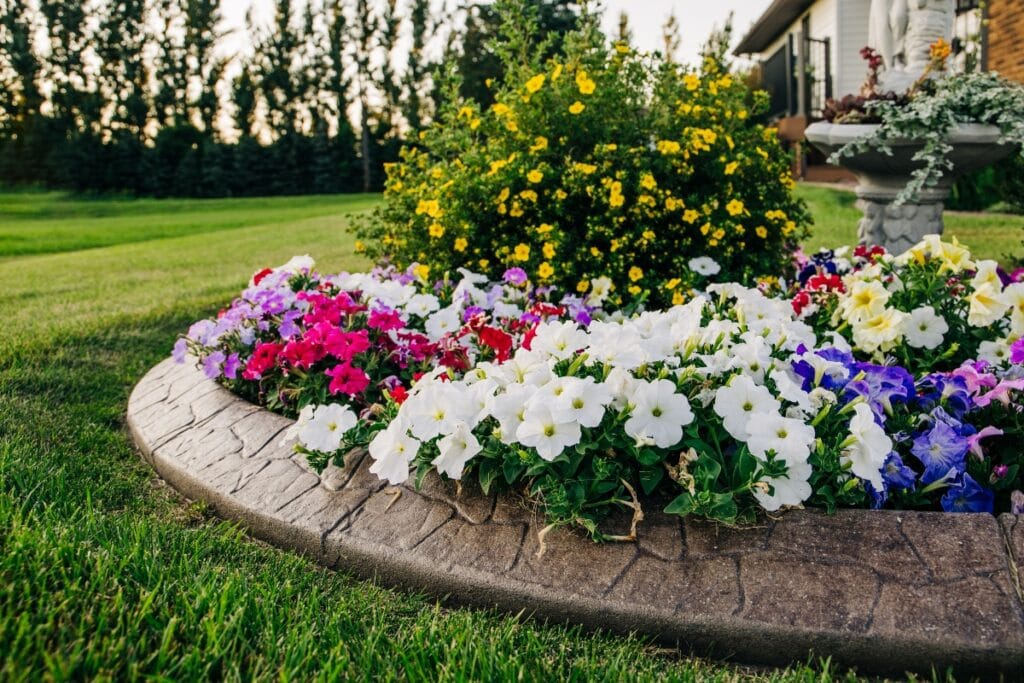
Transform your flower beds with smart mulching and edging strategies. You’ll learn to select the right mulch for your blooms, apply it effectively to support plant growth and install edging that defines your garden‘s shape.
These techniques, along with seasonal maintenance tips, will help you create stunning, healthy flower beds that thrive year-round.
Selecting the Right Mulch for Flowers
When selecting mulch for your flower beds, consider organic options like pine needles or shredded leaves. These materials break down over time, enriching your soil and promoting healthy root growth. You’ll find that organic mulches also help retain moisture, keeping your flowers hydrated during dry spells.
For a more polished look, you might opt for wood chips or bark mulch. These provide a neat appearance and last longer than softer organic materials.
Remember to choose a mulch color that complements your flowers and overall landscape design. A 2-3 inch layer of mulch is usually sufficient to reap the benefits without smothering your plants.
Applying Mulch to Support Blooming Plants
When applying mulch to support your blooming plants, start by spreading a 2-3 inch layer around the base of your flowers, keeping it away from the stems.
This practice helps retain soil moisture, regulate temperature, and suppress weed growth, giving your plants the best environment to thrive and produce vibrant blooms.
You can enhance the benefits of mulching by choosing organic materials like compost or well-rotted manure. These slowly release nutrients into the soil as they break down, feeding your flowers throughout the growing season.
Remember to refresh your mulch layer annually, preferably in spring, to maintain its effectiveness and keep your flower beds looking neat and tidy.
Installing Edging to Define Flower Beds
When installing edging to define your flower beds, start by marking the outline with a garden hose or spray paint. This flexible approach allows you to visualize and adjust the shape before making permanent changes.
Once you’re satisfied with the design, use a spade to cut a shallow trench along the marked line, creating a clean edge for your chosen edging material.
You can choose from various edging options to complement your garden style. Consider using brick or stone for a classic look, or opt for low-maintenance plastic edging for a more modern approach.
Whichever material you select, ensure it’s installed securely to prevent shifting and maintain a crisp border between your lawn and flower beds:
Maintaining Flower Beds Throughout the Seasons
To maintain your flower beds throughout the seasons, adjust your mulching and edging practices as needed. In spring, remove old mulch and refresh with a new 2-3 inch layer, being careful not to bury emerging plants.
Trim your edging to keep clean lines and prevent grass encroachment. During summer, monitor mulch levels and add more if needed to retain moisture and suppress weeds.
As fall approaches, clear fallen leaves from your flower beds to prevent fungal growth. Consider adding a layer of compost before winter to nourish the soil.
In winter, maintain your edging to prevent frost heave and protect delicate plant roots. Here’s a seasonal maintenance guide for your flower beds:
You’ve learned the strategies. Now let’s put them into action. These tips will make your mulching and edging efforts a success.
Tips for Successful Mulching and Edging
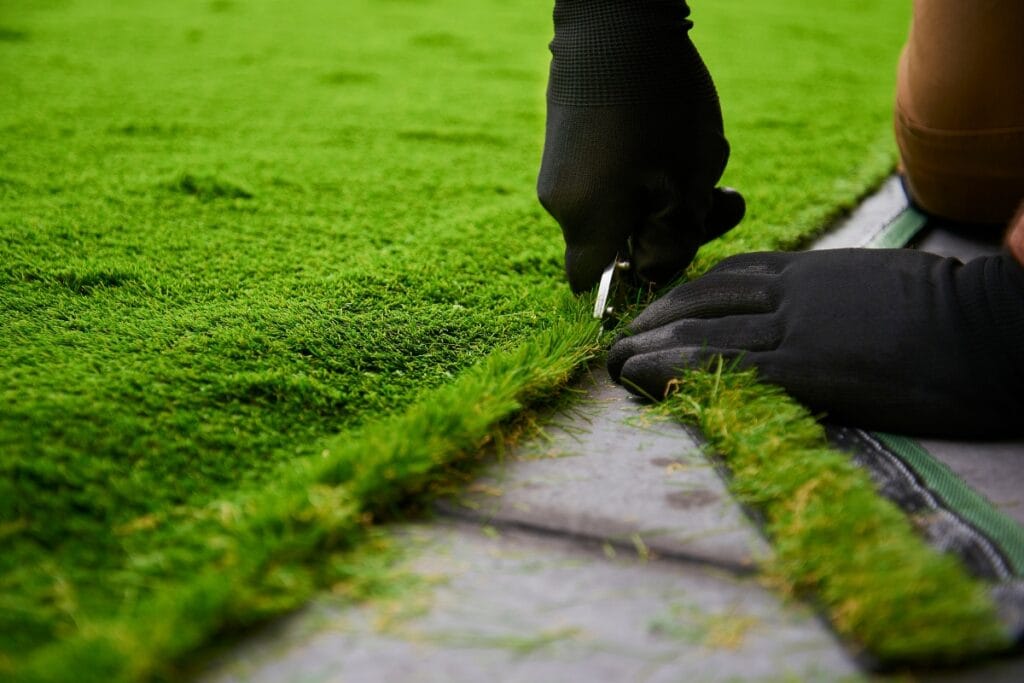
Boost your garden‘s health and appearance with these mulching and edging tips. You’ll learn to select quality materials, follow a step-by-step guide, maintain your garden seasonally, and decide when to DIY or seek professional help.
These practical insights will help you create a thriving, beautiful outdoor space with ease.
Choosing Quality Materials for Your Garden
When choosing quality materials for your garden, focus on organic mulches that decompose over time, enriching your soil. Opt for well-aged compost, pine bark, or hardwood chips, which provide long-lasting benefits to your plants.
For edging, consider durable materials like stone or metal that can withstand weather changes and maintain their shape.
Select mulch that’s free from weed seeds and pests to avoid introducing problems to your garden. For edging, ensure the materials complement your landscape design and are suitable for your climate. Here’s a list of quality materials to consider for your garden:
- Organic mulches: compost, pine bark, hardwood chips
- Inorganic mulches: river rocks, pea gravel
- Edging materials: natural stone, metal, recycled plastic
- Weed barriers: landscape fabric, cardboard
- Soil amendments: aged manure, leaf mold
Step-by-Step Guide to Mulching and Edging
To begin mulching and edging your garden, start by clearing the area of weeds and debris. Next, create a defined edge using a spade or edging tool, cutting a clean line between your lawn and garden beds.
Apply a 2-3 inch layer of mulch around your plants, keeping it away from stems and trunks to prevent moisture-related issues.
For edging, install your chosen material along the cut line, ensuring it’s secure and level. Water the area thoroughly to help settle the mulch and edging. Here’s a simple guide to follow:
Seasonal Care and Maintenance Practices
In spring, refresh your garden by removing old mulch and applying a new 2-3 inch layer around your plants. Trim back any winter-damaged branches and edge your beds to create clean lines. This is also the perfect time to add compost to nourish your soil and prepare it for the growing season.
As summer approaches, monitor your mulch levels and top up as needed to maintain moisture and suppress weeds. Keep your edging neat by trimming regularly, and water deeply during dry spells to encourage strong root growth.
In fall, clear fallen leaves from your beds and consider adding a fresh layer of mulch to protect plant roots during winter.
Deciding Between DIY and Professional Help
When deciding between DIY and professional help for mulching and edging, consider your time, skills, and the size of your project. If you have a small garden and enjoy outdoor work, tackling mulching and edging yourself can be rewarding and cost-effective.
You’ll have control over the materials used and can work at your own pace, adjusting designs as you go.
However, for larger landscapes or complex designs, hiring professionals might be the better choice. They bring expertise in proper techniques, have access to high-quality materials, and can complete the job quickly and efficiently.
If you’re unsure about plant needs or soil conditions, professional landscapers can provide valuable insights to ensure your garden thrives long-term.
Frequently Asked Questions
What are the main benefits of mulching for garden health?
Mulching benefits garden health by conserving soil moisture, suppressing weed growth, regulating soil temperature, and preventing erosion. It also adds organic matter to the soil as it decomposes, improving soil structure and nutrient content over time, leading to healthier plants and reduced maintenance needs.
How does edging enhance the appearance of a garden?
Edging creates crisp boundaries between garden elements, enhancing visual appeal and organization. It separates lawns from beds, defines paths, and contains mulch. This clean-cut look adds structure and professionalism to your outdoor space, improving its overall aesthetic and maintenance.
What are some effective techniques for mulching around trees?
To effectively mulch around trees, start by removing grass and weeds from the base. Apply a 2-3 inch layer of organic mulch, keeping it away from the trunk to prevent rot. Extend the mulch to the tree‘s drip line for optimal moisture retention and root protection.
How often should I refresh the mulch in my flower beds?
Refresh your flower bed mulch annually, typically in spring, to maintain a 2-3 inch layer. However, you may need to replenish more frequently in high-traffic areas or if erosion occurs. Always remove old, decomposed mulch before adding fresh material for optimal plant health and appearance.
Can you recommend some tools for creating clean garden edges?
For clean garden edges, consider using a half-moon edger, power edger, or string trimmer. These tools help create crisp lines between lawn and beds. A manual edging spade or long-handled edging shears can also work well for smaller areas or precise cuts.
Conclusion
Mulching and edging are essential practices that significantly enhance your garden‘s health and visual appeal. These techniques create a thriving, beautiful garden that showcases your plants and reflects your dedication to landscape design.
Achieve a polished, vibrant landscape with the transformative benefits of mulching and edging. These simple yet effective techniques enhance curb appeal, promote plant health, and reduce maintenance. At Legacy Landscape Design, we’re here to bring your landscaping vision to life with professional care and expertise. Call us today at 770-427-2026 or fill out the form on our website to get started. Let us help you create a beautifully defined and thriving outdoor space!
